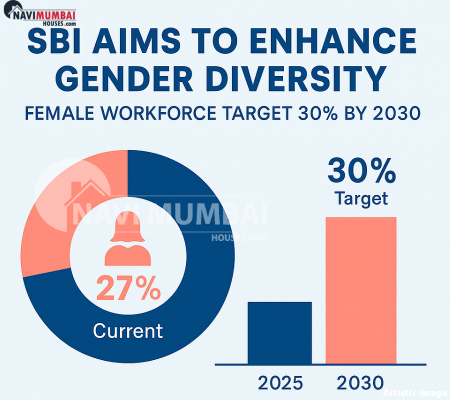
The State Bank of India (SBI), India’s largest lender, has announced a proactive push to enhance gender diversity, targeting 30 % female representation across its workforce by 2030.
Currently, women constitute around 27 % of SBI’s total workforce. Among frontline staff (customer-facing branches), women already make up nearly 33 %, highlighting an imbalance between entry-level roles and higher levels.
With over 2.4 lakh employees, SBI’s gender diversity move is significant in scale.
Goals & Measures: How SBI Plans to Bridge the Gap
To reach the 30 % target, SBI is rolling out several targeted initiatives:
A. Empower Her & Leadership Pipelines
-
A flagship program, “Empower Her”, will mentor, groom, and fast-track women into leadership roles via leadership labs, coaching, and structured training.
-
The aim is not just hiring more women, but building a strong pipeline for higher management and executive roles.
B. Work-Life Balance & Supportive Policies
-
Crèche allowance for working mothers to ease childcare burden.
-
Programs to ease return-to-work after maternity leave, sabbaticals, or extended leave.
-
Health initiatives: breast & cervical cancer screenings, nutrition allowances, and a vaccination drive for women employees.
-
“Family connect” programs to foster understanding and support within employee households.
C. Inclusive Branch Representation
-
SBI already runs 340+ branches manned entirely by women staff, and plans to expand that number.
-
These all-women branches are symbolic and functional, helping create leadership, accountability, and recognition for women in banking roles.
D. Creating a Safe, Inclusive Environment
-
SBI intends to nurture a workplace that is safe, inclusive, respectful, and free from harassment, allowing women to “unleash full potential.”
-
The bank is focusing on representation “across geographies and hierarchical levels” to avoid clustering women in only certain roles or locations.
Challenges & Potential Pitfalls
While the target is admirable, SBI must overcome several challenges:
-
Senior-level attrition/promotion barriers: It’s easier to increase numbers at junior levels; promoting women to senior leadership remains harder.
-
Pipeline quality & readiness: Women must be supported over time with skill development, sponsorship, and the opportunity to handle complex assignments.
-
Balancing attrition & scale: In large organizations, turnover and retirements must be managed so gains aren’t eroded.
-
Cultural/unconscious bias: Deep-seated biases, stereotypes, and workplace culture shifts are harder to change than policy.
-
Geographic/rural diversity: Ensuring women are represented in remote, rural, or less-developed regions is tougher than in urban branches.
-
Tracking & accountability: Bold targets need measurable, transparent progress tracking and accountability at leadership levels.
What Success Looks Like & Impact
If SBI achieves 30 % women representation by 2030:
-
It will set a benchmark in Indian banking, pushing peer institutions to adopt similar targets.
-
Enhanced organizational performance: Studies show gender-diverse teams often perform better in decision-making, risk management, customer empathy, and innovation.
-
Stronger talent attraction & retention: Women will see SBI as one of the foremost employers committed to equality.
-
Balanced decision-making: More women in leadership could bring fresh perspectives to product design, customer outreach, branch strategies, and digital financial inclusion.
-
Wider social influence: A large public sector bank achieving this could influence gender norms in wider corporate India.
What to Watch / Milestones
-
Annual gender diversity reports: Percentage of women in each cadre (entry, mid, senior).
-
Promotion & attrition metrics by gender: Are women being promoted proportionally and retaining roles?
-
Adoption of policies: How many women avail crèche, return-to-work, and leadership programs?
-
All-women branch expansion: Increase in the number and distribution across states.
-
External recognition/benchmarking: Awards, third-party audits of gender diversity efforts.
Conclusion
SBI’s commitment to boost its women workforce to 30 % by 2030 is a noteworthy and promising step in India’s push for gender equity in corporate settings. It goes beyond symbolism — the bank is developing policies, pipeline support, health & safety measures, and inclusive branch models to make this achievable.
Of course, the target is ambitious and will require sustained effort, cultural change, and accountability. But if SBI succeeds, it not only enhances its own talent and brand but also raises the bar for banking in India.
Visit Us: Navimumbaihouses.com or Call Us @ 8433959100
The post Banking on Diversity: SBI to Raise Women Employees to 30 % by 2030 appeared first on .

